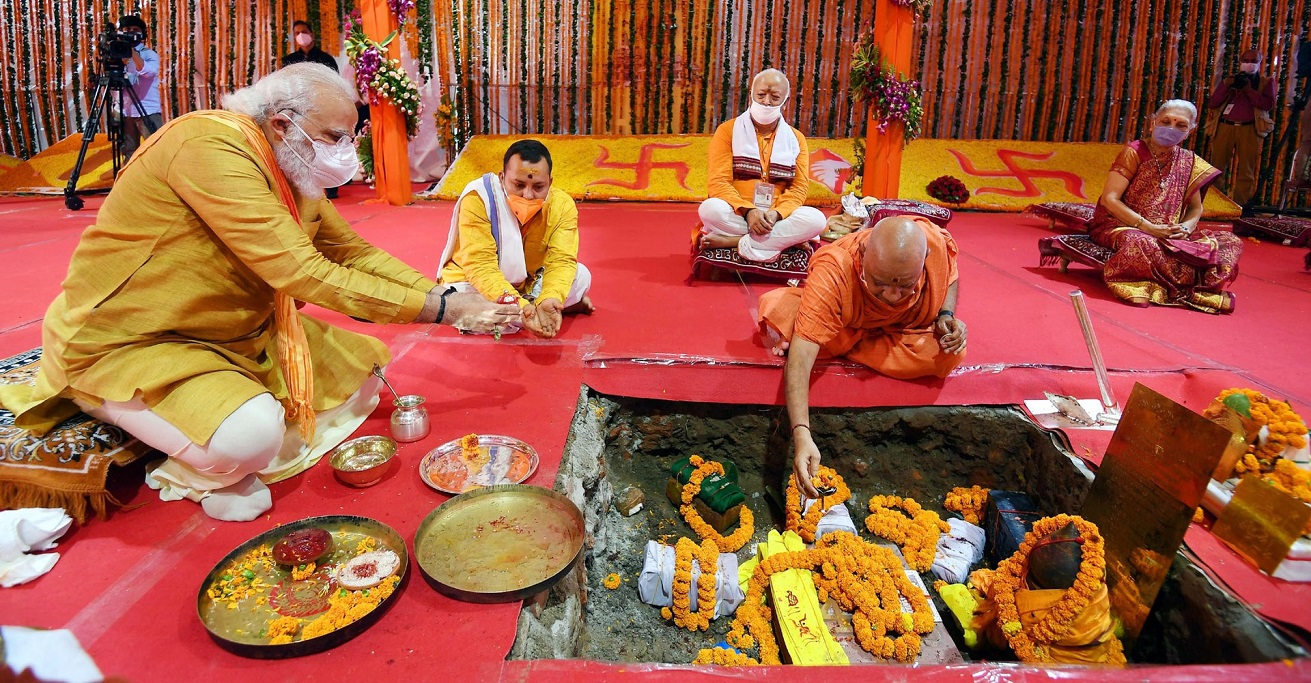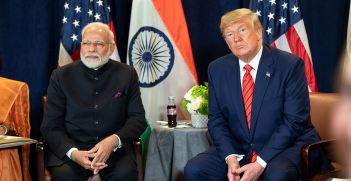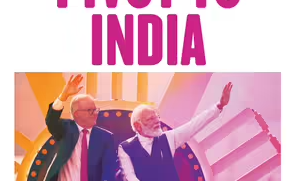Does the Ram Mandir of Ayodhya Mark the Decline of Secularism in India?

The foundation stone-laying for the Ram temple in Ayodhya marks the decline of a secular India and the birth of a Hindu nationalist one. The present Indian government’s active participation in the event simply reinforces this fact.
On 5 August, in the town of Ayodhya, Uttar Pradesh, India’s Prime Minister Narendra Modi laid the foundation stone for a new temple to be built in honour of the Hindu deity Ram. The event symbolised the completion of a three and a half decades-long project of the Sangh Parivar – a collection of Hindu organisations of which Modi’s Bharatiya Janata Party (BJP) is the political wing – to fundamentally alter the character of the Indian state. With this event, India’s existence as a secular, pluralistic society has now passed. In its place, a Hindu-chauvinist state has been born with Modi as its midwife.
In the early 1980s, the religious arm of the Sangh Parivar, the Vishwa Hindu Parishad (VHP), translated as World Hindu Council, began campaigning for the “liberation” of a site in Ayodhya that housed a 16th century mosque built by the Mughal emperor Babur. With little evidence to back up their claim, the VHP had declared that the mosque was built on the very spot where Ram, the central figure of the Hindu epic Ramayana, had been born (Ram Janmabhoomi). The mosque’s presence on this land was touted as a glaring affront to Hinduism.
At the time, the BJP was a fringe political party that had won just two of the 543 seats in Lok Sabha (the lower house of India’s parlaiment) in the 1984 federal election. The party was seemingly no threat to the incumbency of the Congress Party, which was the primary vehicle of India’s independence movement and the party that had constructed the modern Indian state as a multi-religious entity. India’s secularism was built on eschewing religious favourtism, rather than a strict separation of religion and state. However, in adopting the VHP’s agitation as a central component of its Hindutva ideology, the BJP’s political fortunes were transformed.
Being a religious political party, the BJP were aware of two things that assisted in their rise. From religion, they knew that faith was more powerful than facts, and from politics, they understood that emotive narratives were more compelling than evidence-based arguments. So the Ram Janmabhoomi myth became central to the BJP’s platform. Having this as a cause to advocate would set the party against the ideals of the Indian state, and therefore gain it the attention it needed to become a major political player.
While the BJP has an instinctive suspicion of the liberal democratic state developed by the Anglocentric elites of the Congress Party, the primary source of its grievance is actually the Mughal Empire (1526-1857), whose ruling elites were something much worse than Western in education and outlook: they were Muslims. The Babri Mosque became a symbol of this Mughal rule, an Islamic structure that, by its physical presence in Ayodhya, was literally suppressing the religion of the soil. It’s destruction – and replacement with a Ram Mandir – would make India great again.
With this narrative, the BJP had an instrument to polarise the electorate along religious lines to cut through issues of caste and to establish a more unified Hindu identity. This identity would be one based on historical grievance – India’s Centuries of Humiliation. The goal was to create a bloc of voters which would focus its attention solely on these issues of negative identity – the politics of who you are against – rather than policies that could make practical improvements to people’s lives.
Serendipitously, in the late-1980s, India’s public broadcaster Doordarshan began airing an epic 78 week television production of the Ramayana. This was a period when many Indians were first gaining access to household or village television sets, and the production became a collective cultural event. This provided added fuel for the BJP’s co-optation of religion for political purposes, and its romanticism of a glorious former Hindu civilisation that had been crushed by foreign forces.
Come the 1989 federal election, the BJP had increased its presence in the Lok Sabha to 85 seats, enough to be kingmaker in a hung parliament. The following year, BJP president L.K Advani organised a pilgrimage procession (Rath Yatra) to Ayodhya in order to generate publicity for the Ram Janmabhoomi movement. In many cities that his procession travelled through there were riots between local Hindus and Muslims, which prompted the government of Bihar to arrest Advani. Yet many BJP supporters proceeded onwards to Ayodhya and attempted to attack the mosque, resulting in several being killed by Uttar Pradesh police. The movement now had its martyrs.
These events also led to the BJP withdrawing its support for the government of V.P. Singh. A new coalition was only able to last six more months before an election was required. With the BJP’s controversies in hand, the issue of Ayodhya would become a central theme of the 1991 election. The party had been able to successfully shift India’s political culture to place themselves at its heart. From this time forward, whether the BJP won or not, elections would be contested on the issues that they drove.
Yet for such a radical party, the patience and processes of democracy were unsatisfying, and the party instead desired a physical demonstration of its burgeoning power. In December 1992, the BJP, along with the VHP, and the Sangh Parivar’s paramilitary wing the Rashtriya Swayamsevak Sangh (RSS) organised a rally in Ayodhya. During speeches by Advani and other BJP politicians, the crowd of Hindutva devotees stormed the mosque and within several hours had reduced it to rubble.
A commission of inquiry, known as the Liberhan Commission, was launched directly after the mosque’s demolition. It took 17 years for the commission to complete its determination, but in its final report it concluded that the BJP and its affiliate organisations in the Sangh Parivar had intentionally orchestrated the destruction of the mosque, and singled out a number of BJP politicians as either directly or ideologically responsible. The report noted bluntly that “the theme was power.”
Power not only provides you the ability to control circumstances, but it also allows you to avoid any consequences for your actions. In the period between the destruction of the Babri Mosque and the BJP winning a majority government in 2014, the party didn’t have enough power to implement its revolutionary vision for the Indian state, but it did have enough power to avoid any consequences for its attempts. Yet, the rise of Narendra Modi has changed the first part of that equation. With the Congress Party now an ineffectual rump, there are only pockets of regional resistance to the BJP’s authority. Further submission to the party’s vision seems inevitable.
In November 2019, the Supreme Court of India made a decision that waved goodbye to the India of the Congress Party, and ushered in the new India of the BJP. It ruled that the destruction of the Babri Mosque was against the rule of law, but the land should be given to a trust in order to construct a temple to Ram anyway. With Modi laying the foundation stone of this temple in early August the construction of a new Indian state has also symbolically begun. It will be a state built on the animosity of an “injured majority,” who will use their power to cower the country’s religious minorities, and reorganise the state’s structures away from constitutionalism towards majoritarian domination.
Grant Wyeth is a researcher at the Asia Institute, University of Melbourne, and a columnist for The Diplomat.





